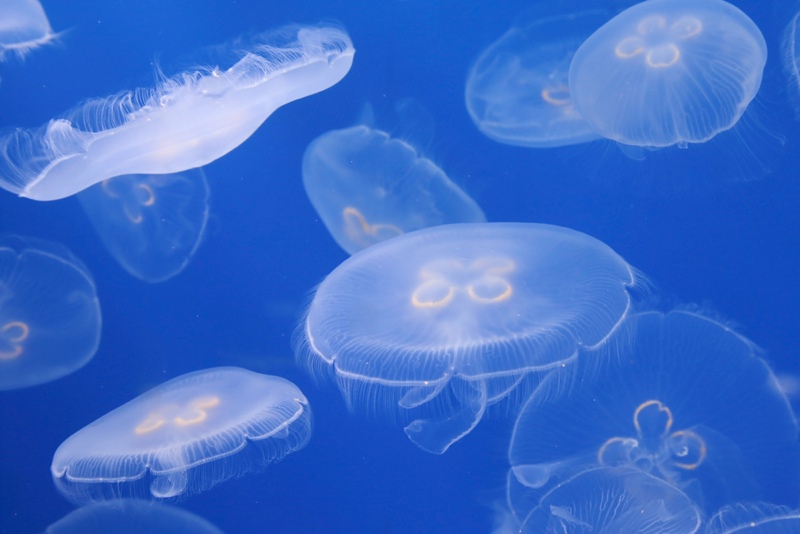Mix-n-Match Arms: Jellyfish Rearrange Limbs After Injury

Common moon jellies have an uncommon fix for injuries: When they lose limbs, they don't regrow them. Instead, they rearrange their entire bodies to stay symmetrical despite the loss.
This "symmetrization" is a never-before-seen method of self-repair, and one that probably helps jellies stay alive in the wild. Jellyfish are a favorite snack of sea turtles, and injuries are common. A 2010 study in the journal Integrative and Comparative Biology found that at least a third of marine invertebrates, including jellyfish, are injured at any given time.
Many invertebrates can regrow limbs, but scientists had never observed this sort of rearrangement before, said study researcher Michael Abrams, a graduate student in biology and biological engineering at the California Institute of Technology (Caltech).
"We've now observed another self-repair mechanism," Abrams told Live Science. "It kind of broadens our definition, a little bit, of self-repair." [See Before and After Images of the Self-Repairing Moon Jellyfish]
Staying symmetrical
The discovery of this new self-repair trick was serendipitous. Abrams and his advisor, Caltech biology professor Lea Goentoro, had plans to study the immortal jellyfish (Turritopsis dohrnii), a species that can revert to its immature polyp stage from adulthood, enabling the animal to live indefinitely. The specimens, ordered from Japan, were taking a long time to arrive, Abrams said, and he wanted to practice jellyfish husbandry and experimentation in advance. So he ordered some moon jellyfish (Aurelia aurita) and started testing their ability to self-repair.
Juvenile moon jellies, called ephyrae, look like little snowflakes. They're just a few millimeters in diameter, with eight symmetrically arranged arms. Abrams started doing some amputation experiments on anesthetized ephyrae to see what they could live through.
Get the world’s most fascinating discoveries delivered straight to your inbox.
"Pretty quickly, we realized that they were doing something very different than what anyone had ever talked about before," Abrams said.
Within hours after losing a limb, the juvenile jellies began rotating their remaining arms around their bodies to regain their lost symmetry. A jellyfish with four arms cut off on one side would, within about four days, look like a symmetrical snowflake again — albeit one with half as many arms as before. [Watch the Moon Jellyfish Rearrange Their Limbs (Video)]
Muscle memory
Depending on how many limbs were lost, between 72 percent and 96 percent of jellyfish managed to regain symmetry. And the symmetry was clearly important for survival: Those jellyfish that failed to get in shape would grow oversized mouths and undersized bells, and languish on the tank floor. Jellies that regained symmetry developed with fewer stomachs (they normally have four) and tentacles due to their lost parts, but managed to otherwise mature normally.
The obvious question was how the jellies managed their bodily rearrangement. The researchers first suspected the animals were growing new cells to push their remaining limbs apart so that the arms would be spaced evenly, or perhaps killing off old cells to pull the limbs closer together. But a search for proliferating or dying body cells turned up nothing. And when the researchers prevented cell death and birth, the jellies still managed to become symmetrical.
"We finally got to the point where we just anesthetized the jellyfish in order to get them not to move anymore," Abrams said.
No movement, no symmetry, the researchers found. In fact, it's the muscular movements caused by the jellyfish's regular pulsations that draw the limbs into place around the body.
"It's kind of beautiful that their normal swimming and feeding process leads to this self-repair. It's normal," Abrams said. The process occurs with as few as two remaining limbs and up to seven, he said.
In theory, the findings could inspire self-repairing materials, Abrams said.
"You don't need to rebuild lost parts," he said. "You're just reorganizing what you have."
The researchers reported their findings Monday (June 15) in the journal Proceedings of the National Academy of Sciences.
Follow Stephanie Pappas on Twitterand Google+. Follow us @livescience, Facebook& Google+. Original article on Live Science.

Stephanie Pappas is a contributing writer for Live Science, covering topics ranging from geoscience to archaeology to the human brain and behavior. She was previously a senior writer for Live Science but is now a freelancer based in Denver, Colorado, and regularly contributes to Scientific American and The Monitor, the monthly magazine of the American Psychological Association. Stephanie received a bachelor's degree in psychology from the University of South Carolina and a graduate certificate in science communication from the University of California, Santa Cruz.



